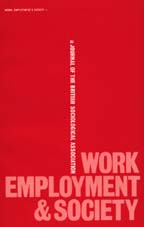Crossref Citations
This article has been cited by the following publications. This list is generated based on data provided by
Crossref.
Mason, David
Button, Graham
Lankshear, Gloria
Coates, Sally
and
Sharrock, Wes
2002.
On the poverty of apriorism: Technology, surveillance in the workplace and employee responses.
Information, Communication & Society,
Vol. 5,
Issue. 4,
p.
555.
Felstead, Alan
Jewson, Nick
and
Walters, Sally
2003.
Managerial Control of Employees Working at Home.
British Journal of Industrial Relations,
Vol. 41,
Issue. 2,
p.
241.
Timmons, Stephen
2003.
A failed panopticon: surveillance of nursing practice via new technology.
New Technology, Work and Employment,
Vol. 18,
Issue. 2,
p.
143.
Winiecki, Donald J.
2004.
Shadowboxing with data: production of the subject in contemporary call centre organisations.
New Technology, Work and Employment,
Vol. 19,
Issue. 2,
p.
78.
Fisher, Michael
2004.
The Crisis of Civil Service Trade Unionism: A Case Study of Call Centre Development in a Civil Service Agency.
Work, Employment and Society,
Vol. 18,
Issue. 1,
p.
157.
Webster, Juliet
2004.
Digitising inequality: the cul‐de‐sac of women's work in European services.
New Technology, Work and Employment,
Vol. 19,
Issue. 3,
p.
160.
Deery, Stephen
and
Kinnie, Nicholas
2004.
Call Centres and Human Resource Management.
p.
1.
Rosenthal, Patrice
2004.
Management Control as an Employee Resource: The Case of Front‐line Service Workers.
Journal of Management Studies,
Vol. 41,
Issue. 4,
p.
601.
Goode, Jackie
and
Greatbatch, David
2005.
Boundary Work.
Journal of Consumer Culture,
Vol. 5,
Issue. 3,
p.
315.
Bolton, Sharon C.
and
Houlihan, Maeve
2005.
The (mis)representation of customer service.
Work, Employment and Society,
Vol. 19,
Issue. 4,
p.
685.
Sewell, Graham
and
Barker, James R.
2006.
Coercion Versus Care: Using Irony to Make Sense of Organizational Surveillance.
Academy of Management Review,
Vol. 31,
Issue. 4,
p.
934.
Valsecchi, Raffaella
2006.
Visible moves and invisible bodies: the case of teleworking in an Italian call centre.
New Technology, Work and Employment,
Vol. 21,
Issue. 2,
p.
123.
Kiss, Simon
and
Mosco, Vincent
2006.
Negotiating Electronic Surveillance in the Workplace: A Study of Collective Agreements in Canada.
Canadian Journal of Communication,
Vol. 30,
Issue. 4,
p.
549.
Ferneley, Elaine H
and
Sobreperez, Polly
2006.
Resist, comply or workaround? An examination of different facets of user engagement with information systems.
European Journal of Information Systems,
Vol. 15,
Issue. 4,
p.
345.
Townsend, Keith
2007.
Recruitment, training and turnover: another call centre paradox.
Personnel Review,
Vol. 36,
Issue. 3,
p.
476.
Winiecki, Don
and
Wigman, Bert
2007.
Making and maintaining the subject in call centre work.
New Technology, Work and Employment,
Vol. 22,
Issue. 2,
p.
118.
Barnes, Alison
2007.
The construction of control: the physical environment and the development of resistance and accommodation within call centres.
New Technology, Work and Employment,
Vol. 22,
Issue. 3,
p.
246.
Winiecki, Donald J.
2008.
An ethnostatistical analysis of performance measurement.
Performance Improvement Quarterly,
Vol. 20,
Issue. 3-4,
p.
185.
Sobreperez, Polly
2008.
Open IT-Based Innovation: Moving Towards Cooperative IT Transfer and Knowledge Diffusion.
Vol. 287,
Issue. ,
p.
179.
Alferoff, Catrina
and
Knights, David
2008.
Customer relationship management in call centers: The uneasy process of re(form)ing the subject through the ‘people-by-numbers’ approach.
Information and Organization,
Vol. 18,
Issue. 1,
p.
29.




